A Lacolle Chronology as it pertains to the English Settlers
The written history of Lacolle can be traced back to July 4th, 1609 when Samuel de Champlain and his entourage stopped briefly at the mouth of a small stream for a meal before continuing southward up the Richelieu River into the lake which now bears his name. In his journal Champlain refered to the location of the delta as "Lacole". When translated literally the term means the neck of a bottle or that which is above the shoulders.
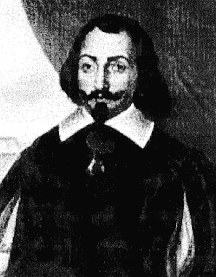
Samuel de Champlain
Under the French Regime little development occurred in the seigniories of New France. In 1733 the King of France granted the northern half of the Lacolle seigniory to Louis Denis de la Ronde. The southern two leagues were granted to Louis Leonard de Beaujeu. Both men served as French officers during the Colonial Wars. By 1741 both tracts were reclaimed by the Crown. In 1743 the southern half of the seigniory was acquired by David Lienard de Beaujeu, son of Louis. In 1752, David Lienard de Beaujeu was granted the northern portion with the condition that both tracts become one seigniory, 4 leagues by 3 leagues. During this period the land was known as the seigniory of Beaujeu.
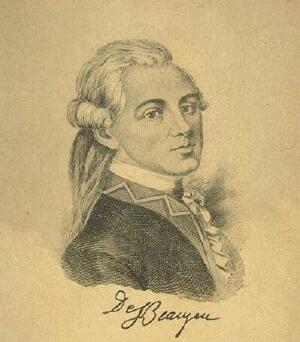
In 1763 British General Gabriel Christie purchased the seigniory from the heirs of Beaujeu after his death in the Seven Years War. After the Conquest of New France, British government officials and military officers who were on the scene could obtain prime lands vacated by the French seigniors who chose to return to their mother country. Gabriel Christie had been stationed at Albany, New York and served as a quartermaster under Wolfe. The Lacolle seigniory was not his only purchase. In 1764 he formed partnerships with fellow officers John Campbell, to purchase the seigniory of Noyan, and Moses Hazen, to aquire the seigniories of Bleury and Sabrevois. In 1766, Christie bought Delery, north of and adjacent to Lacolle. He also aquired the seigniories of Lachenaie in 1776 and Repentigny in 1777. In addition to these seven seigniories, Christie and Hazen shared ownership of farms in the Barony of Longueuil, St Johns and LaSavanne. Christie also purchased a residence in Montreal and property at Chambly. The properties were purchased as investments with the intention of monopolizing on the mill and timber rights.
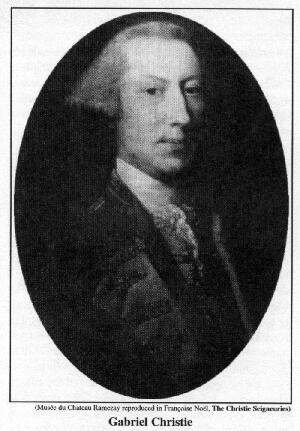
Gabriel Christie's military obligations prior to, during and after the American War for Independence caused him to be frequently absent from Quebec. While away, he maintained the management of his properties with the assistance of James Bell, a millwright settled in St. Johns. In 1784, Christie returned to Montreal after being away for about seven years. The Treaty of Paris, signed the year before, had drasticlly reduced the size of Quebec. It had also redefined the southern boundries of the seigniory of Lacolle.
Soon after Christie's return to Montreal, his son and eventual heir to the seigniory, Napier Christie, married Mary Burton, the daughter of Montreal Governor Ralph Burton. The Burton family were gentry in England who held titles and land in East Yorkshire. As a result of this union, Napier Christie took on the Burton name and acquired title as Lord of Hotham Hall in York and Lord of Hall Bank in Beverley, Yorkshire, England. This marriage event likely influenced the cultural and social development of Lacolle since some thirty years later during Napier Christie Burton's tenure, an overwhelming majority of Lacolle's English settlers were natives of the same Yorkshire regions.
In 1788 the British colonial land management practice of "survey before settlement" was implemented by Gabriel Christie in the seigniory. Prior to this, while under French administration, lots were mapped and borders were defined by ones neighbor or adjacent lot without actual measurement of the lot or the surface area of the land. By using strict measurement in arpent Christie was better able to manage the allotment of the properties and assessment of seigniorial rents and fees, while reserving the right to exploit the timber, mill sites and other natural resources. The first partial survey of Lacolle was undertaken with standard lots being 4 by 28 arpents. Nine concession of 28 arpents in length equaled the three leagues of the seigniory's depth. The settlers, or censitaires as they were called, were subject to ground rent, known as cens et rentes, and land transfer fees, called lods et ventes.
1788 was also the year that Joseph Odell, a Loyalist from Poughkeepsie, NY, sought shelter in Lower Canada. He and his sons received a "location ticket" for 1,036 arpents of land and were eventually granted several lots in the 3rd concession south of the seigniorial domain. (The "domain" was the middle portion of the seigniory of Lacolle which was originally to be reserved by the seignior for his own use. Since Gabriel Christie never occupied the domain, it too was eventually divided up for settlement.) The coming of the Odell family marked the beginning of settlement in the region by Tories seeking reparations for their losses during the revolution and the United States' subsequent reorganization. This was a period when it became obvious to many Loyalists south of the border that they would not be able to maintain their status in America without taking an oath of allegiance. Although these Tories were refered to as Americans, they were, in reality, more loyal to the British Crown than to the new nation of the United States. During the resulting Loyalist migration, both sides of the Richelieu were lightly populated and so, became english speaking territories. The politics of populating the border with loyal english speaking settlers served to defend, as well as temper, potential conflicts along the border.
In 1791 the Canada Act established a new constitution for the colony. A political attempt to abolish seigniorial tenure and to prevent land speculation resulted in a policy of granting properties no larger than 200 acres, thus restricting the seigniors from obtaining any new domain.
The old county of Huntingdon was also established at this time. It streched from St. Regis on the St. Lawrence River to the Richelieu River. Gabriel Christie prepared lists of inhabitants for his seigniories based on heads of household at this point in time. Lacolle had 35 heads of household. To the north, Delery had 21, while on the lightly settled east side of the Richelieu River, Bleury and Noyan had 18 each with 3 in Sabrevois.
In 1797, lots in the 8th and 9th concessions south of domain (the area which would be known as Roxham) were granted. The men who obtained these grants, with names like Calkin, Judd, Swan and Blackleach, did not remain.
In 1798 a boundry dispute arose between the newly surveyed Hemmingford Township and Lacolle along the seigniory's western edge. The problem was attributed to the use of the fluctuating Richelieu River shore line as a basis for the original survey of Lacolle. The dispute continued for over thirty years until a new line was drawn reducing the size of the 9th concession south of domain while adding land to the north.
Gabriel Christie died in 1799 and his son, Napier Christie Burton, was next in line to inherit the seigniory. Burton, a Major General in the 3rd regiment, had become more wealthy than his father. In 1801 Napier Christie Burton appointed Samuel Potts as his Agent. The death of Burton's wife forced his return to England and he didn't return to Canada until after the Napoleonic Wars, and then when he did, it was only breifly.
Around 1808, a major contributor to the political, social and mercantile structure of the Upper Richelieu Valley arrived on the scene. A young Robert Hoyle, native of Bacup, Lancashire, England, left his fellow English associate and relative, George Heyworth, after living several years in Peru, NY. Heyworth was a cloth manufacturer operating in that settlement. Robert Hoyle was possibly influenced by another English entrepreneur named William Bowron when he bought land in Lacolle, Quebec along the border just north of Champlain Town. Hoyle, a timber merchant and trader by occupation found Lacolle to be well situated for his business affairs. Great rafts of primevil timber could be sent down river to Quebec and on to England or southward up Lake Champlain to American mill towns, and then along the Hudson River to New York City. In time Robert Hoyle's younger brother Henry joined him in Lacolle where he too significantly influenced the seigniory's development. William Bowron, who was born in Cotherston, Yorkshire, England, had apparent interests in Lower Quebec's settlement. He was a Quaker trader and relative of Robert Hoyle. According to Robert Sellar, in his "History of Huntingdon County and the Seigniories of Beauharnois and Chateauguay", Bowron lost a fortune in Montreal while engaged in linen manufacturing. By 1822 he was appointed Crown Lands Agent and about the same time he founded Huntingdon Village.
During the festering War of 1812 timber became a necessary commodity. Essential goods were cut off by the conflict. Some friendly smuggling went on to supply the settlers needs. Robert Hoyle established a store at the border, on the Quebec side, to supply settlers of Odelltown and Hemmingford. He and William Bowron contracted to supply beef to the soldiers on the Isle of Noix. Many American settlers vacated their Quebec land holdings along the frontier and removed the the US while waterways into Canada, including the Richelieu River necessitated military travel, staging and subsequent conflict. In November of 1812, General Dearborn with 300 American forces and 200 militia marched nearly to Odelltown, but was defeated by General De Salaberry with two companies of Canadian Voltigeurs, 300 indians and a few militia from adjacent parishes. In September of 1813 General Hampton and nearly 5000 American soldiers entered Odelltown and remained there for two days. Hampton then marched westward toward the head waters of the Chateauguay River planning to attack Montreal, but he was also beaten back by De Salberry and his Canadian forces. Again in March of 1814, General Wilkinson and 5000 American troops prepared to attack Odelltown and Lacolle. Again, the Americans were turned back by the Canadians. The war ended with little being settled.
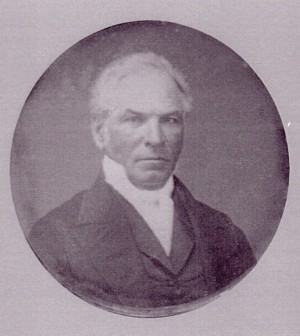
Robert Hoyle
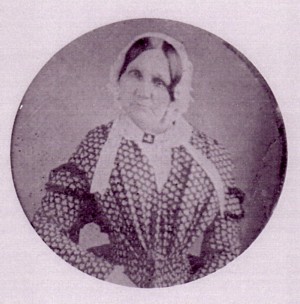
Eliza Bartlett Nye Hoyle
In 1815 Canada's Surveyor General, Joseph Bouchette, published a topographical discription of Lower Canada. Scattered farms and cleared fields were evident along the road through Odelltown to Burtonville. Bouchette discribed well tended roads, fields, gardens and orchards. Additional clearings were noted in the northeast along the Richelieu River. Routes of travel were highlighted as were Indian camps which existed along the Lacolle River near the present village of Lacolle.
1815 was also the year that Edme Henry, the well established son of a French Army surgeon, became Napier Christie Burton's Agent of the Domain. Henry's administration was marred by poor relations with the censitaires and complicated by incomplete record keeping and non-collection of seigniorial rents, fees and arrears. During Henry's term, he loosened the grip on seigniorial privleges by leasing mills and writing deeds which no longer reserved timber rights. From this a petty bourgeoisie emerged who were able to influence the social and economic development of Lacolle and the other Chrstie seigniories.
In 1816 Henry Hoyle traveled to Lacolle from Lancashire to examine and take title of land pledged as security for a loan to his older brother, Robert. Just as Henry Hoyle was to return to England, he met and courted Sarah Visscher Schuyler of Troy, NY. They were married in early 1817 and took up residence on her estate. Born Sarah Visscher, she was a member of the "Old New York Aristocracy". She was the widow of Henry Ten Eyck Schuyler who was once aid-de-camp to General George Washington. Henry Schuyler was also the nephew of American General Phillip Schuyler and the son of Brig. Stephen Schuyler. Sarah's own ancestry included Brig. John Visscher, her father, and her British Loyalist uncle, Lieutenant General Gerrit Visscher, as well as first cousin and eventual US President Martin VanBuran. Henry Hoyle adopted Sarah's three daughters and one son and together they had three additional sons. Hoyle and his new family remained in Troy stock farming until an apparent falling out with his American in-laws in 1824.
In 1820, after a brief post-war cooling off period, Lower Canada was again proclaimed "open for settlement". Pioneers began moving into East Hemmingford and Lacolle. Many new arrivals during this period were English farmers from Yorkshire who were escaping that country's depression of the post-Napoleonic Wars years. By settling in this predominantly english-speaking area, they were better able to avoid cultural and linguistic barriers. Clusters of English immigrants, many of whom were Methodist, settled in Beaver Meadows, Roxham and Henrysburg, as well as throughout the seigniory of Lacolle during the 1820s and early 1830s. Few other seigniories or townships in Lower Canada were so densely populated with Englishmen. By 1851, while seasoned with Scotch, Irish and early American settlers, the vast majority of Lacolle's english-speaking population was of English origin. Evidence of a large migration from Yorkshire, England is noted in R.P. Hastings' "Essays in North Riding History":
"There was no further substantial emigration to the New World, however, until the post-war depression after 1815. The first wave of these emigrants departed to Canada from Hull in April, 1817. April was the normal departure month for Canada since the emigrant, after landing in Quebec, could just plant a crop which could carry him over the winter. The "Nancy" of Hull, however, was still advertising passages in May. Eventually the last three vessels left Hull in June, carrying between them 180 emigrants from Yorkshire and Lincolnshire. Nine earlier ships had already taken 560 men, women and children to Canada that season. A year later the race for emigration from this neighborhood still continued unabated across the Atlantic. By April 1819, two vessels had already left Hull for Quebec and six or seven others were ready to take emigrants to Canada and the USA. Vessels leaving from Hull and Whitby, as opposed to Liverpool, had the advantage of a slightly shorter route via the Pentland Firth. In both cases emigrants acted as ballast for ships traveling to America to pick up cargoes of timber and ships' stores."
England's next national peak in emigration came in 1827 and 1828. Again, Hastings notes: "...a Scarborough apprentice witnessed the departure of 130 emigrants, most of them country people, on a ship for Quebec in March 1828. The "Crown" also sailed for the St. Lawrence from Whitby carrying emigrants from the district in the same year. By 1829, however, the agriculture, lead, alum, shipbuilding and whaling industries were simultaneously in difficulty. Consequently emigration reached its highest point... from 1829 to 1834. In April of 1829, numerous vessels left Hull for Quebec and New York carrying males and females of every age... and class of society. In March, 1830, the middle classes of whole parishes were reported to be preparing to leave and it was anticipated that 8,000 people would embark during the season from Hull alone. In the first six months of the year there were only 2,893 departures from Hull but this was over three times more than had gone in 1829 and more than had left during the nine preceding years. Encouraging reports from earlier emigrants, the similar language and habits of the people and a voyage of only a few weeks duration were given as reasons for their choice. Between 1831 and 1834, 5,894 emigrants sailed to Quebec from Hull and 6,089 from Liverpool alone. These were not the only ports of embarkation. 1,026 persons also left for Quebec from Whitby, 557 from Stockton, and 62 from Scarborough during the same period."
In Lacolle the Yorkshire migration's impact was already being felt as early as 1822 when Mark Elvidge, a Kilham, Yorkshire native aquired lot number 46 in the 4th concession south of domain from Edmond Weldon and Joseph Odell. Elvidge, who had been farming in the parish of LaTortue, had three sons for whom Lacolle farms were later established. Mistakenly referred to as "Eldridges Corners" in Sellar's History, the landmark was the site of the Jackson, or Beaver Meadows, Cemetery. Eventually a large tract of Lacolle farmland was in the Elvidge name. In addition to the farms, some of the family operated a store along the border during the middle of the century.
On May 12, 1823, English settler Richard Harper, then farming in the parish of St. Constant, purchased lot number 65 in the 5th concession south of domain from Thomas Boyd Esq. Later, Harper acquired an adjacent lot from Henry Hoyle in exchange for his St. Constant land along the LaTortue River. His property in Lacolle, later to be known as Harper's Corners, is mentioned in Sellar's History as the spot where 220 volunteers and militia from Havlock, Covey Hill, Hemmingford and Sherrington paused by Harper's "roomy two story edifice" for breakfast enroute to the November 7, 1837 conflict at the Bullis Farm. The vicinity, known as Beaver Meadows, was also the site of Harper's schoolhouse and a Methodist Church in the second half of the 19th century.
The arrival of the English was also marked by the organization of the Methodists in the region. Around 1822 a group of English from Roxham were coordinated by an area Methodist preacher who quickly spread the word to the Hemmingford flock. About the same time, a similar Methodist revival was taking place in Odelltown and Burtonville. Soon the Odelltown Circuit was established including classes from Bogton, Roxham, Beaver Meadows and Burtonville. In June of 1823, the first meeting of the building committee for the Odelltown Church was held at the home of Roswell Canfield. At the same time, plans were made to build another church in the settlement of Burtonville. A sweeping fire devastated that small community soon after and its new wood framed church was lost. Construction of the Odelltown Church began that year on lot 30 of the 2nd concession south of domain. Contractors were John Graves, mason and John Waudby, carpenter.
It was also in 1823 that Joseph Odell hired Joseph Whitman to survey land where the road from Odelltown to Burtonville crossed the Lacolle River. Thirty six village lots were laid out establishing the village of Lacolle. Within ten years, the village had a post office.
The English continued to pour into Lacolle, many migrating there after a brief stop at Laprarie. William Beswick, from Brompton, Yorkshire came in 1823 and settled in the northeast corner of the seigniory near Stottsville. His son Richard became a teacher at Odelltown and a Methodist class leader during the mid-century.
Joseph Keddy, from Pickering, Yorkshire, England, arrived about the same time following his brother George's lead. George Keddy had been granted land near Henrysburg in 1821. He and his wife had no children. Joseph Keddy settled on the eastern boundry of Hemmingford where a clearing had been made by a military encampment from the war of 1812. Joseph Keddy's oldest son, John, operated a store in Bogton during the second half of the 19th century. The vast properties owned by the Keddy family in Lacolle and east Hemmingford amounted to over 1000 acres, including land at Roxham which is now the site of Park Safari.
In 1824 Henry Hoyle left Troy, New York after a falling out with his in-laws. After setting fire to a number of Schuyler family portraits, the enraged Hoyle headed north to establish himself and his faithfull wife and children on his Lacolle property along the border near Champlain, New York. His estate at Lacolle compared to the one left behind at Troy. He named it Roecliff Manor after his boyhood estate at Bacup, Lancashire, England. It would eventually become Lacolle's seigniorial mansion house and estate.
Another English settler who in Lacolle by 1824 was Edward Braithwaite. From Bubwith, Yorkshire, England, Braithwaite acquired land in Henrysburg, establishing a store there around which the Methodist community grew.
In 1825 Francis Cookman arrived in Lacolle. Cookman was a highly esteemed Englishman known as the "Father of Bogton". Another East Yorkshireman, from Owthorne parish, he fostered a sabbath school and managed a day school for over 17 years. The arrival of Cookman coincided with the census count undertaken in 1825. The expanding population of Lacolle was listed as 1,875.
With the influx of settlers ongoing, it became nessesary to complete the first full survey and map of the entire seigniory with concessions and lots. This task was undertaken and completed by Joseph Whitman in the years 1826 and 1827. By its completion, settlers were pouring into Lacolle at a feverish rate.
In 1827 brothers Hewson and John Paine of Maltby le Marsh, Lincolnshire, England settled in Henrysburg but were set back by a devastating fire.
Charles Ellerton, a native of Cottingham, Yorkshire, England settled in east Hemmingford in the same year. Eventually Ellerton acquired lot 10 on the 9th concession of domain, Lacolle. This area, which blossomed into the community known later as Hallerton, was mistakenly so named. Originally it was to be named Ellerton after this prominant man and his family. A son, Robert Ellerton, later served a distinguished career in Hemmingford politics.
Another settler who arrived in 1827, and deserves mention, was William Akester, a tailor and farmer from Beverley, Yorkshire, England. The Akester family were regarded as a cornerstone of the Roxham community.
1828 was the year that Ralph Moore of Muston, Yorkshire, England came to Canada. Moore acquired land in Lacolle on the 3rd concession north of domain. He was elected mayor of St. Bernard de Lacolle in 1858. By 1900 his farm sold for $10,000. After being invested, that sum grew to over one million dollars.
In 1830 "Old Huntingdon County" was divided into three sections under the names of L'Acadie, Beauharnois and LaPrairie. In July of that year Robert Hoyle was commissioned Lt. Col. of the 2nd Battalion of the L'Acadie Militia. That fall Robert Hoyle was elected to the Provincial Parliament as a representative for L'Acadie.
Surveyor General Joseph Bouchette published three descriptive volumes on the region in 1831, including a new map of Lacolle. In the six years since the last census, the population had increased by about 300 people to 2,154.
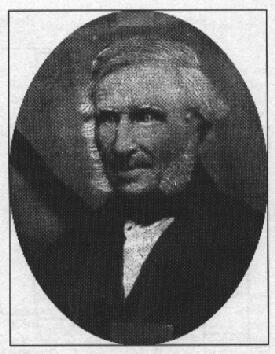
John Cockerline
Yorkshireman John Cockerline settled in Henrysburg in 1833 after an unusually long voyage of 16 weeks. Cockerline's father-in-law Marmaduke Jackson also settled in the seigniory of Lacolle. After nearly 170 years, Cockerline descendants continue to farm the same land.
Sometime around 1835, Charles Collings of Cornwall, England settled in Lacolle. He acquired lot 11 on the 9th concession of domain, a relatively large lot measuring 156 arpents in superfice. The Collings family were prominent Hallerton residents and members of the St. John the Baptist Anglican Church congregation after its establishment.
By the mid 1830s a number of Irish families had joined the influx of British. An Irish Protestant named James Glass settled his family in a stone house in Roxham about this time. Glass is said to have come from Vinigar Hill in Wexford County, Ireland. A significant battle occured at that place during Irland's Wexford Rebellion. Glass' son John held 700 acres of property on two farms in Roxham by 1850.
On the second day of January, 1835, Napier Christie Burton died in London. Due to an "entail" in Gabriel Christie's will, another son, William Penderlieth Christie, inherited the seigniories. He quickly appointed his nephew, William Mcginnis as full time Agent. W. P. Christie invested more in his estate and was more benevolent towards his censitaires than his half-brother Napier. He encouraged Protestantism among both the english and french speaking populations in his seigniories. During his tenure as seignior he supported preacher William Dawes and others involved in an Anglican revival along the Richelieu River. He also attempted to attract more loyal British subjects to the region. By this time though, Upper Canada's appeal was growing among the Protestant immigrants. In spite of his efforts, the English population acctually decreased.
The mid 1830s also marked the movement of more French settlers into the upper Richelieu Valley. In 1835, the French community of Pleasent Valley or Belle Vallee was established in Lacolle. Described as a group of small log homes, it eventually included a school and later a post office.
As mentioned an Anglican revival also began during this period. From this came the organization of a Church of England in Henrysburg in 1836.
The year 1837 was a bad one for the order of Quebec. Many French settlers were led into rebellion by Louis Papineau. In Lacolle, Henry Hoyle suffered an attack of paralysis and palsy and, as a result, relied heavily on his step son-in-law, Douw K. Lighthall, of Huntingdon Village to manage his administrative affairs.
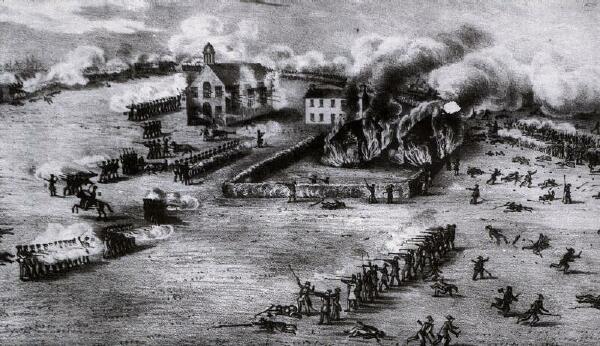
The November 9, 1838 Battle at Odelltown
Lacolle was the scene of two significant battles during the Papineau Rebellion, both occuring in the late fall of 1838. About 220 militia and volunteers from Havlock, Covey Hill, Hemmingford and Sherrington marched through Roxham to reinforce those facing the rebels in the November 7, 1838 stand at the Bullis Farm. Again, on the 9th of November Odelltown became a battlefield when nearly 1200 rebels unexpectedly engaged about 200 loyal defenders in and around the Odelltown Church. On both occaisions the rebels were forced to retreat.
After the rebellion, many French-Canadian settlers in Delery and Bleury were implicated. W. P. Christie attempted to rid his seigniories of the French-Canadians who participated and did so to some extent by successfully recovering land from a number of absentees seeking refuge accross the border.
The 1840s brought three more churches to the seigniory of Lacolle. The New Connexion Methodist Church was founded in Henrysburg in 1841 and a Church of England organized in Lacolle Village the following year. The third was the building of the Roxham Methodist Church at the end of the decade.
In 1843 the Chambly Canal was completed. Lots along the Richelieu River were subject to extensive flooding. Seigniorial rents had to be adjusted to satisfy affected land owners.
Also in 1843, within the seignioiy of Lacolle, the Parish of St. Bernard de Lacolle was organized and in Roxham a cemetery was established. By the year's end, William Penderleith Christie had gone to England seeking treatment for his failing health.
W.P. Christie died on the 4th of May, 1845. Heirs to the seigniory of Lacolle were Gabriel, James and Gabriel the younger Tunstall. They in turn leased the seigniory to Henry Hoyle who then became the Seigneur Usufruitier or significant landholder.
The census of 1846 revealed a well-developed population of 3,228 in the seigniory of Lacolle. Across the seigniory, there were 5 taverns, 3 stores with liquor, 1 each of grist, saw, fulling and carding mills and 2 threshing mills. There were also 3 pot or pearl asheries, 2 tanneries, a brewery and a trip hammer forge.
In 1849 Henry Hoyle leased the seigniory of Delery but died shortly thereafter. At the time of his death Henry Hoyle owned 1,806 arpents of land in the seigniory of Lacolle. His son Timothy was next in line to become Agent and Seigneur Usufruitier.
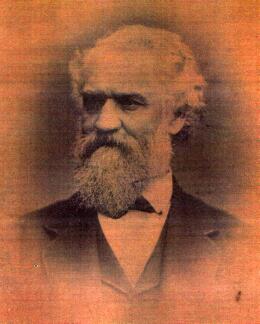
photo provided by Plattsburgh State University of New York Special Collections
Timothy Hoyle
This extract from Madame Francoise Noel's "The Christie Seigneuries" is evidence of the impact that Henry Hoyle had on the region.
The inventory after his (Henry Hoyle's) death gives an idea of the nature of this operation and its size. His own property was farmed by tenant farmers on shares. He also owned a large amount of livestock which was either let out for increase or which he placed to winter on 49 different farms throughout southern Lacolle, Hemmingford, Noyan, and Caidwell Manor. On his own farms, he had 18 cows, 2 bulls, 2 colts, 2 horses, 14 sheep, and 7 calves together valued at £1 39. 10; let out he had 43 cows, 22 heifers, 26 steers, and 123 sheep valued at £310.05. Hoyle had been doing this for some time and there were some outstanding written debts for livestock to a value of £91. The emphasis on raising sheep evidently complemented his manufacturing interests: Hoyle was in effect putting out the sheep required for his manufacturing interests and advancing the capital (in sheep) to stimulate the production of wool in the area. As with McGinnis, therefore, Hoyle's activities were diverse and included manufacturing as well as farming and land speculation.
The Roxham Methodist church was erected ca 1849, being the third of the three 1840s churches noted earlier. The wood framed building, which seated 120, was raised on a 69 square foot lot located on the northeast corner of lot 130 in the 9th concession south of domain and was situated on the west side of the road. The lot was purchased from Luke Bravender.
By 1851 the census of the seigniory revealed a
population of 3,483. Of those, 1,760 were english speaking and 1,723 spoke french as a mother tongue. There were 1,886 Catholics and 1,597 Protestants.
The Seigniorial Act of 1854 marked the commutation of seigniorial tenure. As a result, a property enumeration known as Cadastre Abrege was undertaken and finally completed by 1861. Although, by its completion both Hoyle brothers were dead and buried in Champlain, NY, their estates had not yet been settled. In counting their land holdings at this juncture, the Hoyle estates included 3,070 arpents of land in Lacolle, second only to merchant brothers Freeman and Bartlett Nye with 6,208.
The 1850s was a decade of development and recognition for the small community of Hallerton on the western border of Lacolle. A population of settlers established a few miles north of Roxham and along Williams Road, united to form its own formal community. At one point the settlers applied for a post office. When a name for the place was needed, the group agreed on the name Ellerton, after the prominant local settler Charles Ellerton and his family. When the application was processed a clerical error occured and the post office address subsequently became Hallerton instead of Ellerton. The Hallerton schoolhouse was completed in 1857. This building known to many as Hallerton Hall was built on property donated by the Collings family. The reorganization and relocation of Hemmingford's Anglican Church contributed to Hallerton's further development by including construction of a second church, in Hallerton, to provide for the settlers of the congregation located in that region. Although the church was built under the direction of Reverend DuVerney and part of the Hemmingford circuit, it was actually raised accross the road from Hallerton Hall, on on property within the seigniory of Lacolle. The Saint John the Baptist Church was completed by 1860. That same year Alex McCrea purchased a corner of Charles Ellerton's farm and operated a store on the spot. Two years later, in 1862, the store burned but it was quickly rebuilt by the Hallerton community. The store was later sold to a Mr. Blair who then hired a young man named Edmund Kenney as store clerk. Twenty two years after the original store was built, it was again sold. This time Edmund's father, Thomas Kenney, bought the business thus establishing the landmark firm of Kenney and Son.
The small hamlets of Lacolle, with their clusters of English settlers, seemed to thrive in the mid 1800's, but the futures of these small communities were in no way secure. Of course the strength of the Catholic Church and the gaining French population, both locally and throughout Quebec, influenced the eventual outcome. There were other factors as well. The coming of the railroad, the draw of the big cities and the lure of the west in the later years of the century would also take their toll on these small farming communities. The focus of politics shifted from the local level to issues of national concern as isolation decreased across Canada.
In 1864, the policy of Confederation was adopted in Canada as a way to remedy a deadlock in the Parlament over public education and representation. confrences in the Maritimes and Quebec were held to hash out the details of a possible union. A "Quebec Scheme" was adopted but eastern provinces were opposed. Trade policies between the US and Canada changed in 1865 as a result of the Civil War. A negitive impact was felt by Canada and this increased the the desire for a political union to strengthen inter-provincial trade. In 1866, the Fenian Raids further advanced the cause of the Confederation by showing a need for uniting and thereby strengthening Canada's defenses. By this time the British Government and public opinion are in favor of the union. In March of 1867, Queen Victoria signed the British North America Act establishing a constitution for the new order. By Royal proclamation it came into effect on July first of that year when Upper Canada (Ontario) and Lower Canada (Quebec), Nova Scotia and New Brunswick were united into the Dominion of Canada.